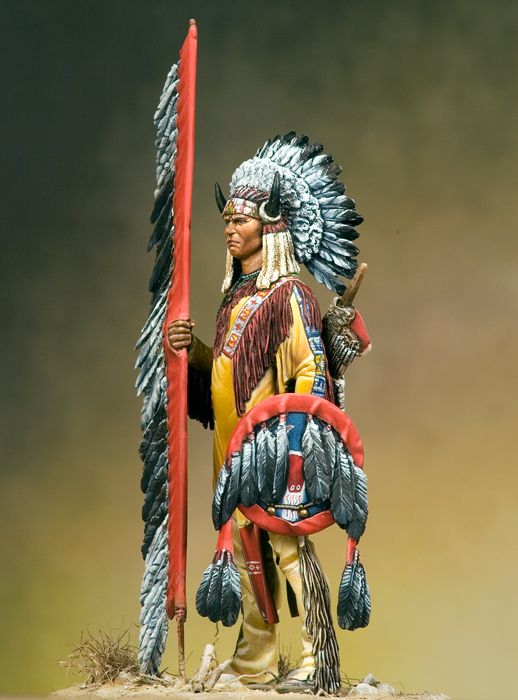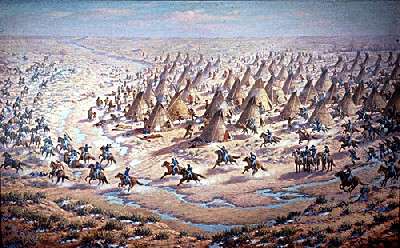
The Arapho were one of the many Algonkin tribes and migrated along with the Cheyenne from area around Wisconsin to the Buffalo plains. A move which became even more inviting after the Spanish introduced the horse to the American continent. The northern bands eventually becoming closely allied with the Sioux and the southern bands with the Kiowas and the Comanches.

Arapaho has diverged very significantly phonologically from its posited proto-language, Proto-Algonquian (Proto-Algonquian *maθkwa "bear" became Arapaho wox, and Proto-Algonquian *weθari "her husband" became Arapaho ííx).
To the white man the Great Plains were little more than a wilderness that had to to be crossed to reach the riches that lay beyond. Yet trails such as the Oregon trail, which effectively split the buffalo into a northern and southern herd, were resented for the damage they did to the Indians hunting grounds.
 The Arapaho were amongst the 8,000 - 12,000 Indians who attended the Horse Creek council of 1851 and signed the subsequent treaty which was designed to protect white travellers using the trails. However by 1861 Denver itself, as well as the numerous mining camps and ranches along the trails, had become squatters on land previously assigned to the Indians at Horse Creek. model make models
The Arapaho were amongst the 8,000 - 12,000 Indians who attended the Horse Creek council of 1851 and signed the subsequent treaty which was designed to protect white travellers using the trails. However by 1861 Denver itself, as well as the numerous mining camps and ranches along the trails, had become squatters on land previously assigned to the Indians at Horse Creek. model make models
Federal Agents responded by calling a Council at Fort Lyon where Little Raven and several other Chiefs were persuaded to sign a treaty allotting them a small reservation in South-east Colorado. However the treaty was rejected by the bulk of the Arapaho and Cheyenne nations and subsequently repudiated by Little Raven and the others.

John Evans who had been appointed Governor of Colorado around the same time, claimed in the fall of 1863 that the plains tribes were planning a general uprising in the spring of the following year. Although no evidence was ever produced to support his claim. Then in April 1864 Colonel John Chivington, the ruthless Indian-hating military commander of Colorado, accused the Cheyenne of stealing 175 cattle, again without proof. The punitive raids against innocent Indians that followed serving only to inflame the situation.
The Governor invited friendly Indians to camp near military posts for protection while troops pursued the 'hostiles'. However Left Hand's attempts to hold a council with the drunken commander of Fort Larned met with little success. Wrongly accused of stealing the Forts horse herd he found himself and his warriors fired on under a flag of truce. The southern bands of Arapaho's and Cheyenne's responded by joining forces with the Sioux effectively stopping all travel across the River Platte trails.
attempts to hold a council with the drunken commander of Fort Larned met with little success. Wrongly accused of stealing the Forts horse herd he found himself and his warriors fired on under a flag of truce. The southern bands of Arapaho's and Cheyenne's responded by joining forces with the Sioux effectively stopping all travel across the River Platte trails. Evans was authorised by Washington to raise a a hundred day regiment of enlisted men, the Third Colorado Calvary.
Evans was authorised by Washington to raise a a hundred day regiment of enlisted men, the Third Colorado Calvary.
The Governor invited friendly Indians to camp near military posts for protection while troops pursued the 'hostiles'. However Left Hand's
 attempts to hold a council with the drunken commander of Fort Larned met with little success. Wrongly accused of stealing the Forts horse herd he found himself and his warriors fired on under a flag of truce. The southern bands of Arapaho's and Cheyenne's responded by joining forces with the Sioux effectively stopping all travel across the River Platte trails.
attempts to hold a council with the drunken commander of Fort Larned met with little success. Wrongly accused of stealing the Forts horse herd he found himself and his warriors fired on under a flag of truce. The southern bands of Arapaho's and Cheyenne's responded by joining forces with the Sioux effectively stopping all travel across the River Platte trails. Evans was authorised by Washington to raise a a hundred day regiment of enlisted men, the Third Colorado Calvary.
Evans was authorised by Washington to raise a a hundred day regiment of enlisted men, the Third Colorado Calvary. Meanwhile in an effort to limit the war, Major Edward W. Wynkoop of Fort Lyon arranged a peace conference between Evans, Chivington and several Cheyenne and Aarapaho 'peace' chiefs.
Meanwhile in an effort to limit the war, Major Edward W. Wynkoop of Fort Lyon arranged a peace conference between Evans, Chivington and several Cheyenne and Aarapaho 'peace' chiefs.  Believing they had made peace Left Hand's band set up camp at Sand Creek along with Black Kettle
Believing they had made peace Left Hand's band set up camp at Sand Creek along with Black Kettle  and the other Cheyenne chiefs under Wynkoop's protection, while Little Raven above and 600 Aparaho set up camp on the Arkansa river.
and the other Cheyenne chiefs under Wynkoop's protection, while Little Raven above and 600 Aparaho set up camp on the Arkansa river.
Following complaints about Wynkoop's policy towards the Indians from Chivington to his superior, Major-General Samuel R. Curtis (A man who believed the proper way to keep Indians in their place was to punish them), Major Scott J. Anthony was placed in charge of Fort Lyon. Anthony continued to encourage the Indians to remain camped near the Fort while waiting for Chivington's men to join him.
At dawn on the 29th of November they attacked Sand Creek with 750 men. Anthony boasting that the 'Indians will be properly punished'. Only 4 Arapaho's survived the attack, while a 137 Cheyenne's (over a 100 women and children) were brutally murdered and mutilated. They then set out to repeat the massacre at Little Raven's camp, only to find it already abandoned, before returning to Denver.
A combined force of 1,600 Sioux, Arapaho and Cheyenne warriors responded by attacking and wrecking 75 miles of the River Platte trail in a single day, before heading north to join their relatives in 'Powder River country'. Then in July of the following year a combined force of 3,000 warriors attacked the River Platte bridge. General Connor and 3,000 troops were sent after them with orders to destroy the Powder River camps, but only managed to burn down a single Arapaho camp before being forced to retreat.
In October, the government decided to offer peace terms, making treaties with Little Raven Arapaho's and Black Kettle's Cheyenne. It was one of the few occasions in the history of the West when the United States Government was forced to admit its guilt and make reparations (to the survivors of Sand Creek). A condition normally imposed on the Indians. It turned out to be a little more than a brief truce however.
A renewed wave of settlement soon brought new pressures to bear on the Plains tribes and in 1867 Little Raven was amongst the 5,000 Indians attending the Medicine Lodge peace Council. He like the Cheyenne chief Black Kettle believed continued resistance would only lead to the destruction of his people and agreed to move to a reservation in the Indian Territory, in return for the right of the Arapaho to hunt game on their old range between the Arakansas and Platte rivers.
 However the Army responded with a winter campaign of attrition that made the Indians position untenable. The Northern Arapaho, a once proud and wealthy tribe of 2,000 people were reduced to just 938 (198 of whom were warriors), by the time of their surrender. After spending a year at Camp Robinson as destitute POW's they were offered temporary refuge by their old enemies the Shoshoni on their Wind River Reservation in Wyoming, where they still live today.
However the Army responded with a winter campaign of attrition that made the Indians position untenable. The Northern Arapaho, a once proud and wealthy tribe of 2,000 people were reduced to just 938 (198 of whom were warriors), by the time of their surrender. After spending a year at Camp Robinson as destitute POW's they were offered temporary refuge by their old enemies the Shoshoni on their Wind River Reservation in Wyoming, where they still live today.
At dawn on the 29th of November they attacked Sand Creek with 750 men. Anthony boasting that the 'Indians will be properly punished'. Only 4 Arapaho's survived the attack, while a 137 Cheyenne's (over a 100 women and children) were brutally murdered and mutilated. They then set out to repeat the massacre at Little Raven's camp, only to find it already abandoned, before returning to Denver.

A combined force of 1,600 Sioux, Arapaho and Cheyenne warriors responded by attacking and wrecking 75 miles of the River Platte trail in a single day, before heading north to join their relatives in 'Powder River country'. Then in July of the following year a combined force of 3,000 warriors attacked the River Platte bridge. General Connor and 3,000 troops were sent after them with orders to destroy the Powder River camps, but only managed to burn down a single Arapaho camp before being forced to retreat.
In October, the government decided to offer peace terms, making treaties with Little Raven Arapaho's and Black Kettle's Cheyenne. It was one of the few occasions in the history of the West when the United States Government was forced to admit its guilt and make reparations (to the survivors of Sand Creek). A condition normally imposed on the Indians. It turned out to be a little more than a brief truce however.
A renewed wave of settlement soon brought new pressures to bear on the Plains tribes and in 1867 Little Raven was amongst the 5,000 Indians attending the Medicine Lodge peace Council. He like the Cheyenne chief Black Kettle believed continued resistance would only lead to the destruction of his people and agreed to move to a reservation in the Indian Territory, in return for the right of the Arapaho to hunt game on their old range between the Arakansas and Platte rivers.
Northern Arapaho Bands
The Northern Arapaho warriors were part of the Indian force responsible for the annihilation of Custer at the Little Bighorn in 1876. However the Army responded with a winter campaign of attrition that made the Indians position untenable. The Northern Arapaho, a once proud and wealthy tribe of 2,000 people were reduced to just 938 (198 of whom were warriors), by the time of their surrender. After spending a year at Camp Robinson as destitute POW's they were offered temporary refuge by their old enemies the Shoshoni on their Wind River Reservation in Wyoming, where they still live today.
However the Army responded with a winter campaign of attrition that made the Indians position untenable. The Northern Arapaho, a once proud and wealthy tribe of 2,000 people were reduced to just 938 (198 of whom were warriors), by the time of their surrender. After spending a year at Camp Robinson as destitute POW's they were offered temporary refuge by their old enemies the Shoshoni on their Wind River Reservation in Wyoming, where they still live today.
No comments:
Post a Comment